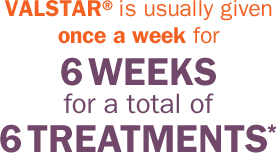
WHAT IS VALSTAR®?
VALSTAR® (valrubicin) is a liquid medicine put directly into the bladder with flexible tubing called a catheter. VALSTAR® is used for patients whose CIS bladder cancer did not respond to treatment with a drug called BCG or Bacillus Calmette-Guerin and who cannot have surgery right away to take out the bladder.
IMPORTANT SAFETY INFORMATION ABOUT VALSTAR®
- You should not receive VALSTAR® if you are allergic to polyoxyl castor oil or to medicines called anthracyclines; if you have been told by a doctor you have a hole in your bladder or a weak bladder wall; if you have a urinary tract infection or if you have been told by a doctor that you have a small bladder.
- Only about 1 in 5 patients no longer had CIS bladder cancer 6 months after treatment with VALSTAR®. If you do not respond to VALSTAR®, waiting to have your bladder taken out increases the chances that the bladder cancer can spread to other parts of your body which can lead to death. You should talk with your doctor about the risks of waiting for surgery to have your bladder taken out when you have CIS bladder cancer. If your CIS bladder cancer does not respond to VALSTAR® after 3 months or if your CIS bladder cancer comes back, you should talk with your doctor again about having surgery to take out your bladder.
- To prevent VALSTAR® from entering other parts of your body, your doctor will check your bladder before treating you with VALSTAR®. If you have been told by a doctor you have a hole in your bladder, a weak bladder wall, or are having a certain type of surgery for your bladder, your doctor may choose to delay your treatment.
- Tell your doctor if you have severe irritation in your bladder before receiving VALSTAR®. You may not be able to hold the VALSTAR® in your bladder for the whole time or it may leak out. You may have pain or irritation of your bladder during or shortly after getting VALSTAR®. For the first day after getting VALSTAR®, your urine may have a red color. This is normal. Tell your doctor right away if you have pain or if you have red-colored urine after the first day of getting VALSTAR®.
- Women should not become pregnant and men should take measures to prevent their partner from getting pregnant during treatment with VALSTAR®. If you plan to be sexually active, talk with your doctor about possible risks and use the birth control method recommended by your doctor. Women should stop nursing before starting treatment with VALSTAR®. VALSTAR® may affect male reproductive fertility.
- During or after getting VALSTAR®, common side effects included urinating often, difficulty urinating, a strong need to urinate right away, bladder spasm, burning and pain, blood in urine, not making it to the bathroom in time to urinate, bladder inflammation, urinary tract infection, need to urinate at night, stomach pain, and nausea. These are not all the side effects of VALSTAR®. For more information, ask your doctor or pharmacist.
- Talk to your doctor or nurse about any questions you may have about your treatment with VALSTAR®. For more information call Endo Pharmaceuticals Inc. at 1-800-462-ENDO (3636).
Please see full Prescribing Information.
Intended for U.S. Residents Only
VALSTAR® is a registered trademark of Endo International plc or one of its affiliates.
© 2023 Endo International plc or one of its affiliates. All rights reserved.
- Privacy/Legal
- VL-05017; VL-05019/May 2023
- www.ValstarSolution.com
- 1-800-462-ENDO (3636)





Talk to your doctor about scheduling your treatments or about any questions you may have about your treatment with VALSTAR®.
Treatment may take place in your doctor’s office, in a hospital, or in a clinic. Your doctor will determine the time you will need to stay at the medical facility for each treatment.
Delay first treatment for at least two weeks after bladder surgery.